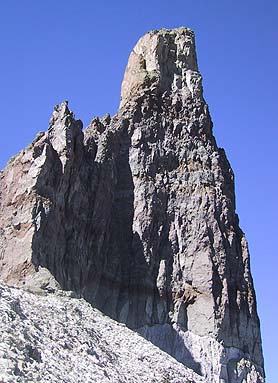
Copyright © 2001 by George I. Bell
Lizard Head from the south.
The standard route
lies just
behind the left skyline.
|
Lizard Head
By
George Bell
(gibell@comcast.net)
Written 1/16/2002; Climb date 9/9/2001
[Click on any image for the full size version]
View Ellingwood's account of the first ascent
|
|
Lizard Head ... is the most difficult of Colorado summits to reach.
In fact the rottenness of its 400' tower makes safety too much a matter of luck
for comfort. Returning visitors have formed the opinion that the peak has
become noticeably rottener and more dangerous. Our advice ... when you reach
the base, take [a] picture and go home.
Robert Ormes in the Guide to the Colorado Mountains, Seventh Edition,
1979
|
The above passage was the first thing I read about Lizard Head, in 1982, and
it did not make me want to run out and climb it. However, recently an unusual
planetary alignment and the recommendation of my astrologer convinced me to go
for it ...
NOT! In reality the trip was borne out of more mundane needs. This summer I
had done some Flatiron scrambles with Gerry and Jennifer Roach, and they
mentioned that Jennifer was trying to finish off the 13ers by the end of the
summer, having only ten or so to go. One of those remaining was Lizard Head, a
formidable barrier for Jennifer. Jennifer is a prolific peak-bagger, but knew
that the technical challenges of the peak would be difficult for her. Gerry
had climbed Lizard Head a few years ago and knew well what she was getting
into. He didn't have any interest in repeating the climb (not a good sign,
perhaps).
Gerry recommended she Jumar the two hard pitches, and had her practicing
with Jumars.
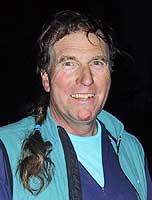
|
Gerry Roach, 6AM on the approach
Copyright © 2001 by
George I. Bell
|
Since they were both between jobs, the Roach's were free to climb full time.
They had already attempted the peak in August but were thwarted by bad weather.
One definitely does not want to be near the summit of Lizard Head in a
lightning storm. In September they figured to simply hang out in southwest
Colorado until Lizard Head was climbed. Since I was constrained by weekends,
it looked like they would probably find someone else to lead Jennifer
up the peak.
But their next attempt, the day after Labor Day, with Charlie Winger, ended
after the first pitch due to slowness and bad weather approaching.
When Gerry and Jennifer called me to ask me to drive down the next weekend, I
accepted without hesitation. Gerry's view was that the climb would be safest
with a team of three. He didn't want Jennifer to have to clean pieces while
jumaring, and a team of four would knock too many rocks on each other. Gerry
himself didn't seem too keen on climbing Lizard Head for the second time, and
asked if another of the Minions would be interested in being the third for the
climb. By this he meant
"Satan's Minions Scrambling Club",
a group of Flatiron scramblers who believe in getting up early and knocking
off a few easy climbs before work. At the last minute, John "Homie" Prater
agreed to accompany me on a quick trip to Lizard Head.
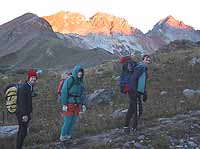
|
John, Jennifer and Gerry
Mt. Wilson and Gladstone behind
Copyright © 2001 by
George I. Bell
|
We started driving on Saturday at noon. An early storm had dumped snow in the
high country around Denver (thus ending Homie's attempt at a Pfiffner
Traverse), but Gerry and Jennifer were already in Telluride and assured us the
snow had not hit there, and the weather Sunday was forecast to be perfect. We
arrived at the Cross Mountain Trailhead just about dusk, and met with Gerry and
Jennifer in their cozy camper. Jennifer was psyched that we had made it and
offered us some canned beef stew and tea, which tasted great in the rapidly
dropping temperatures.
It was clear and cold that night (for September) and I didn't get much sleep,
out in the open in front of my car. When John and I awoke at 4:30, is was 23
degrees and my water bottle was half frozen. At 5:30 it was still dark as we
shouldered our packs and trudged up the trail toward the shadowy form of Lizard
Head.
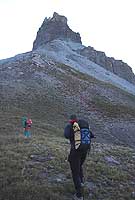
|
Approaching Lizard Head
(click to see route)
Copyright © 2001 by
George I. Bell
|
It was a gorgeous clear morning as the sun rose. As we got above timberline
we got a great view of the Wilson Group to our West, and of course the hulking
black form of Lizard Head. It reminded me of Castleton Tower the way it sits
high on a talus cone. All too soon we had trudged up the cone and were
shivering at the base at around 7:30. Man was it cold! It is too bad the
route faces SW, as it gets no morning sun. There was wind coming out of the
north, but fortunately we were somewhat protected on this side of the tower.
Jennifer had prepared well for this climb, and a lot of this meant keeping us
psyched - she feared we would wimp out! As I pondered the first lead I found
myself with two hand warmers, drinking hot tea. I wasn't too concerned as the
weather was obviously stellar, and eventually we would be in the sun. The rock
looked better than expected, and Gerry could offer beta on the first pitch at
any level of detail desired.
After considerable organization and waiting around for warmth, I started out
on the first pitch. This lead can be broken up into two 60' pitches, but I
opted to combine these. The first 60' is scary because all the handholds
appear loose, and the pro isn't trustworthy. At the 60' anchor I warmed my
hands. The next 60' is a steeper crack, and appears more difficult than the
lower section, but the rock and protection are quite good. A tricky 5.7
lieback deposits you right in a notch, and I was now in the sun.
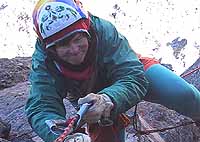
|
Jennifer jumaring the first pitch
Copyright © 2001 by
George I. Bell
|
I belayed John up and remarked that the rock on the upper part of the pitch
was "as solid as Eldo". Just then John dislodged a mass of pebbles from the
back of the crack. Gerry and Jennifer were wisely hanging out far from the
landing zone. Perhaps it wasn't as solid as Eldo, but the rock was best just
where the climbing was hardest. We fixed the second rope for Jennifer to
jumar. She worked up slowly but steadily as Gerry hung onto the end of the
rope to make it easier to jumar. At some point the generated rockfall made
this too risky, however. John belayed Jennifer on the other rope, as a
neophyte jumerer, she wanted the security of a toprope.
Jennifer was quite excited to make the notch, with half the hard pitches now
behind her. The second pitch could be done completely unroped if it wasn't for
the exposure. It's an easy romp up a standard loose scree gully, except that
this scree gully dumps out over a 150 foot cliff. The first move out of the
notch is quite exposed, and a foothold crumbled on me here. I just stepped
back into the notch, but it is definitely the hardest section on the second
pitch (and tricky going down).
The way I went, the second pitch ended in the middle of a scree field, even
with our 60m ropes. Just above me was a large truck-sized boulder, and I was
able to get some pro in it, although it wasn't clear how stable the whole area
was. Jennifer and John tied in 20 feet apart and I quickly belayed them up.
The third pitch breaches a steep headwall, and it's not obvious which way to
go. Gerry had shown us a photo of the start of this pitch, but I still wasn't
sure of the way. There was an obvious crack, but it was overhanging at the
start and looked offwidth up higher. Looked pretty tough for a route rated
5.7, but Gerry had already warned us that the crux on this pitch was more like
5.9 (or 5.7, A1).
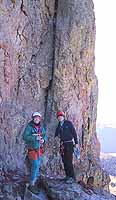
|
The Crux Pitch
Copyright © 2001 by
George I. Bell
|
I racked up and started up the pitch.
It was
immediately steep, but the rock again was quite good. I clipped an old pin and
inched up under the overhang. There was a small icicle hanging under the
overhang, giving it a distinctive alpine flavor. I placed the #3.5 Camalot and
started cranking over the overhang. The best hold was a fist crack to the
right, this section was very pumpy and I felt at the verge of coming off.
However, this section is well protected (or easy to aid) using two large
Camalots (we had a #3.5 and #4).
Above here the climbing got easier but entered a flared offwidth crack. It
looked much easier than the section below, but there wasn't much pro available.
The face to the right was very featured and looked climbable, I headed out here
for 15' or so but detoured back to the wide crack at the top when the runout
began scaring me. There wasn't any pro in the crack either, but I felt safer
wedged in the flared slot.
After passing a final chockstone, I reached a fixed anchor and looked up at
another easy scree slope to the top. We were almost there!
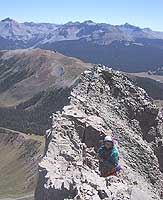
|
Looking SE from the
summit, note crack.
Copyright © 2001 by
George I. Bell
|
We fixed the second rope around a huge pinnacle for Jennifer, and waited for
her to arrive. The day was still perfectly clear and we were quite comfortable
although still dressed in quite a bit of polypro. Remarkably, there was
another team climbing the first pitch behind us (Gerry had told us of this on
the radio). Gerry had told us before that the climb was too dangerous for two
teams of climbers. The top pitch is quite easy - except for the yawning drop
on all sides, and I scrambled up unroped. The summit ridge is a real knife-edge,
and on the other side drops vertically for hundreds of feet, maybe even a
thousand. There is also a crack a few feet back from the edge which extends
the length of the knife edge, making one the feel that the whole top is about
to peel off.
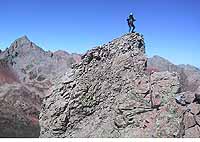
|
Jennifer on the summit,
looking NW.
Copyright © 2001 by
George I. Bell
|
When Jennifer arrived, we discussed the best strategy for getting her to the
top. Eventually, John led up to the top, placing a few pieces, and then backed
down the same way. This left some pro for Jennifer to clip in to as she led to
the summit. Really the only way to fall on this pitch would be to slip and
land on a pile of loose blocks that all started to slide off the edge. An
unlikely series of events, but it could happen. I played the role of the
roving photographer as I moved around snapping photos of everyone reaching the
top.
I was the first to rap down the crux pitch, and I then belayed Jennifer by
grabbing the end of the ropes as she rapped. I soon found out this was a
dangerous position to be in, as volleys of rocks were inadvertently released by
every rappeller. At this point we ran into the party behind us, a man and
woman. They were quite happy to hide under an overhang while we finished
rappelling the crux pitch. I was quite surprised later when the woman began to
lead the crux pitch. I figured with her small hands the lead had to be 5.10,
and she did pop off right at the start when a hold broke. But she was fine and
cruised the crux, using small face holds rather than the crack. Ugh, was it
really that easy?
The loose second pitch was problematic as it is so low angle you can't rappel.
Jennifer and John down-lead it, which was a time consuming process. I then
followed them down to the notch, taking out a few pieces of pro that John had
left. Fortunately, the climb diagonals to the left, so the lower pitches are
somewhat protected from rockfall generated by climbers high up.
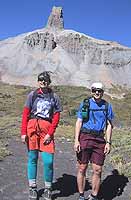
|
Jennifer and John,
happy to be done.
Copyright © 2001 by
George I. Bell
|
Down at the base I encountered Gerry, who had been enjoying the sun on a
grassy ledge lower down. He congratulated us and remarked how nice it was to
be on a climb where he did not have to do any work! The base of the climb was
not a place for casual chitchat, however, with the volley of stones
accompanying every rappeller. I was also concerned about rockfall from the
other party high above us. Gerry had been studying this and advised us to stay
less than 5' out from the base of the cliff, as all rockfall hit beyond that
distance. But I did not want to stick around and test the theory, so we
quickly packed up and raced down the talus cone to the security of flat grass.
Here we spent some time relaxing, eating, and re-packing. We were all very
happy to have completed the climb quickly and without any major problems.
Jennifer was especially psyched, for she had fewer than five thirteeners to go
now, and with the last major obstacle out of the way, was certain to finish
this year. I hadn't even completed all the fourteeners, and was really in no
hurry to do this. But I could see what a huge accomplishment this would be,
taking at least 10 years even for very driven peak baggers.
I was most amazed by the fact that this climb had been first done in 1920 by
Albert Ellingwood and Barton Hoag using only a hemp rope and three soft iron
pitons.
This was a landmark achievement in 1920 on such a steep, loose tower.
If I had to select one climb in Colorado that seemed most ahead of it's time,
this would be it.
Click here to view Albert Ellingwood's
account of the first ascent.
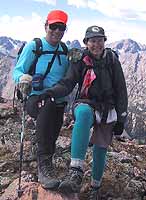
|
Gerry and Jennifer Roach
atop peak "N", Gore Range.
Copyright © 2001 by
George I. Bell
|
On the hike out Jennifer amazed us with more stories of mental stamina in her
two attempts on the Hard Rock 100 mile race (she finished it once), and Gerry
had an interesting tale of how he had been kicked out of the CMC, when he was a
young and impressionable climber. Although he had felt ashamed about it at the
time, looking back he now saw it as a positive influence on his climbing career
as it had forced him to search out new partners and not rely on the club
atmosphere so much. We all then drove down to eat in Ridgeway, with much talk
of even more obscure and difficult summits in Colorado. Homie and I continued
driving through the night and did not arrive home until nearly 2AM.
Two days later planes smashed into the World Trade Center and Pentagon,
altering our world forever. Somehow a dangerous pile of rubble like Lizard
Head seems friendly
compared to a malevolent human out to get you.
Two weeks later John and I joined Gerry and Jennifer on the climb of
Jennifer's final
thirteener, Peak "N" in the Gore Range. Jennifer became only the eighth
(official) person
to climb all the ranked thirteeners.
 Trip Report Index ...
Trip Report Index ...









